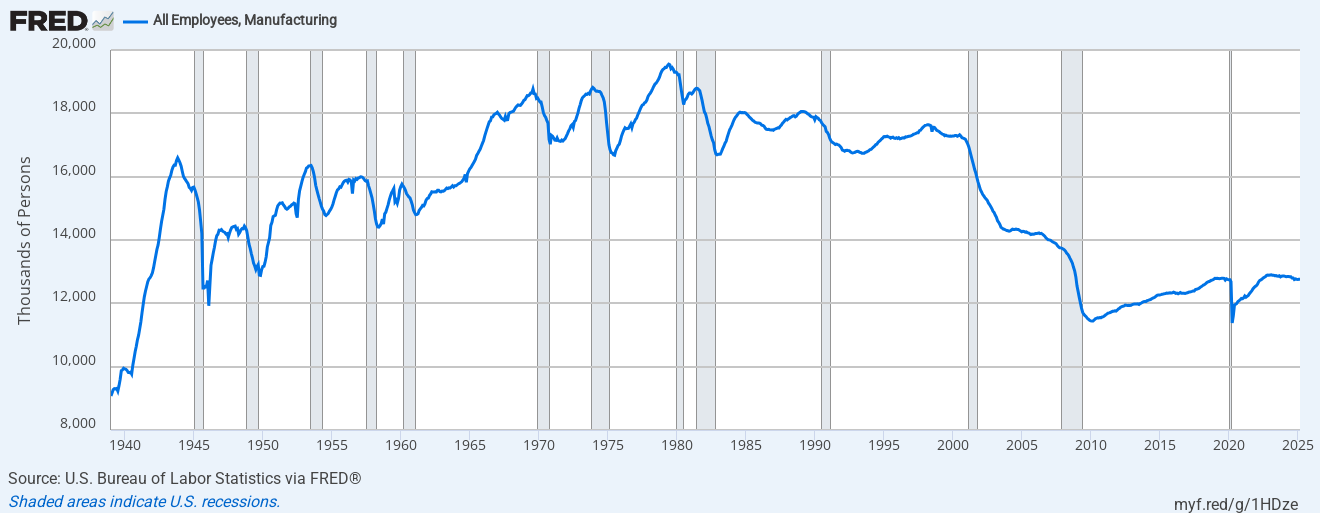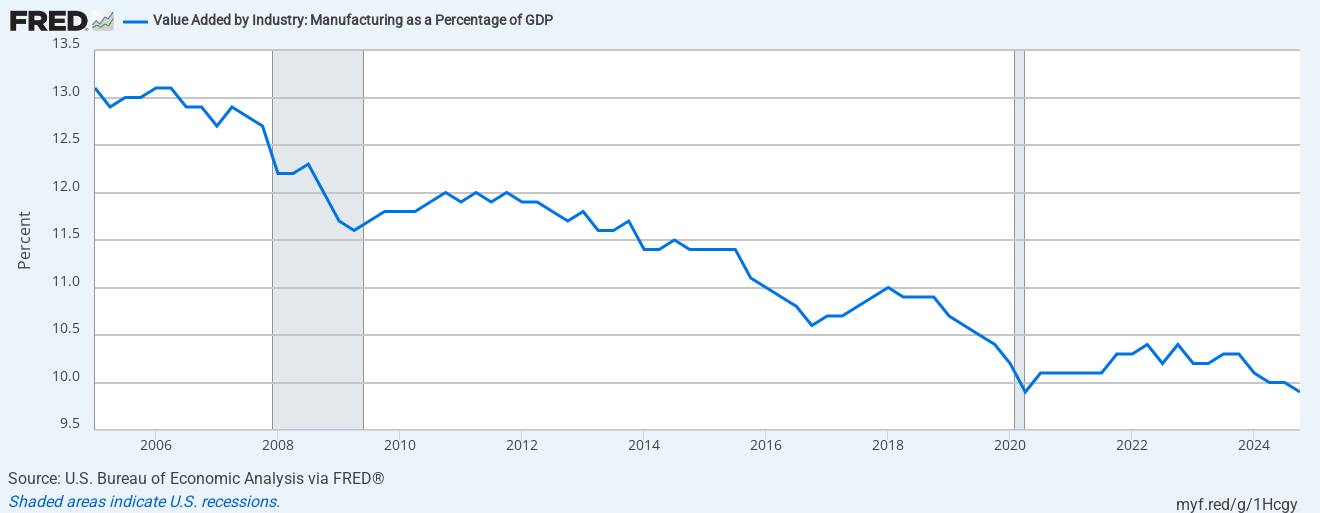Reports of American Manufacturing's Death are Greatly Exaggerated
It seems everyone these days is lamenting the death of American manufacturing. The people selling this story are using it to justify their policy proposals. Trump’s stated reason for his erratic trade policy is to revive American industry. But purveyors of protectionism are starting with a flawed premise; American manufacturing isn't dying.
Proponents of this narrative might point to a graph showing the decline of employment in the manufacturing sector like the one below.
This is true for much of the world, even countries that are manufacturing powerhouses like Japan, Germany, and South Korea (although definitely not China). This is to be expected as productivity gains from automation mean fewer people are needed per unit of output. Still, manufacturing employment is down.
Next, they might point to manufacturing’s reduced contribution to US GDP.
The graph makes the change look more dramatic than if the axis wasn’t truncated. But I’ll allow it is a smaller percentage of GDP than it was 20 years ago.
So manufacturing employment and share of GDP is down. But that doesn't mean American industry is in decline. That is a question of if the US is making less shit.
Is the US Making Less Shit?
Below is a graph of a manufacturing index, indexed to 2017.1 Since the recovery from the 2008 financial crisis and ignoring Covid, US manufacturing output has stayed pretty steady by this measure. It’s not booming, but it isn’t dying.
But that’s just one measure of US manufacturing output. An alternative measure shows US manufacturing growing, by real value added. It has US manufacturing output growing by about 30% since 2005 to $2.4 trillion at the end of 2024. That puts the US at number two in value added in manufacturing.
So, what does the US actually produce? According to the NIST, “In terms of value added, the largest subsectors of manufacturing are chemical products; food, beverage, and tobacco products; and computer and electronic products…” The US also leads the world in aerospace and defense manufacturing. It is the most dominant country in medical devices. It is the second largest vehicle producer and the fourth largest steel maker.
So why are people proclaiming the death of American manufacturing?
Why the lie?
Some people I think are genuinely misinformed. I’m speculating, but I think the reduction of manufacturing employment left deep psychological scars in communities hit hard by the workforce reduction. Places like the Rust Belt. These changes affected people in the middle of their careers who were laid off, but also their children whose future prospects were upended. In places like Buffalo, it really does seem like American manufacturing died.
That gives political actors an opportunity. If you tell these communities “American manufacturing is dead, but I’ll revive it like Lazarus,” you can get their vote. The dumbest way to do this is through protectionism. That leaves industrial policy of which I’m skeptical, although I could be sold on specific policies. But none of this is necessary (and the first is definitely counterproductive) because American industry isn’t in decline. But it can be juiced up.
If it’s not dead, should we do anything?
There are plenty of policy changes that could make US manufacturing even more competitive than it already is. For example, getting rid of tariffs on intermediate goods like steel and aluminum, which stand at 25% (although who knows what it’ll be next week). This would be a boon to the manufacturers who consume them (e.g. automakers and aerospace manufacturers). Taking the abundance pill and getting rid of obstacles to bring new renewable energy online would drop electricity prices. Industrial customers used 35% of all energy in 2023 in the US. Driving down electricity prices would drive down their costs. Getting rid of the Jones Act would lower transportation rates reducing costs for manufacturers and consumers, in turn boosting demand for manufactured goods.
Policy makers and researchers should be discussing how to improve the environment for American industry, but any discussion needs to begin with an important truth; American manufacturing is not dead.
Due to a change in the version of the North American Industry Classification System (NAICS) used to construct the index, values starting in 2004 cannot be directly compared with values published in 2003 and earlier. So what does this graph show?








